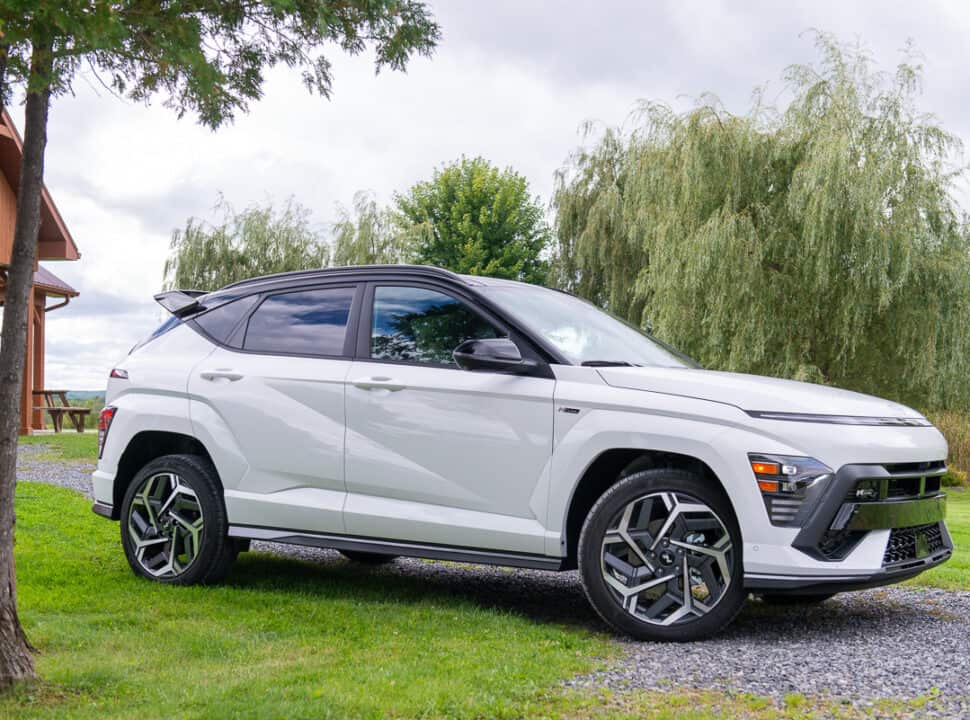If there’s one thing Hyundai does well, and perhaps a bit underrated, it’s producing sporty-looking crossovers that move. Sure, we all love the sporty looks with those bigger wheels and cosmetic add-ons, but if handling and power don’t match up, it’s a fail in our books.
Related – Hyundai SUV Models Up Close: Smallest to Biggest
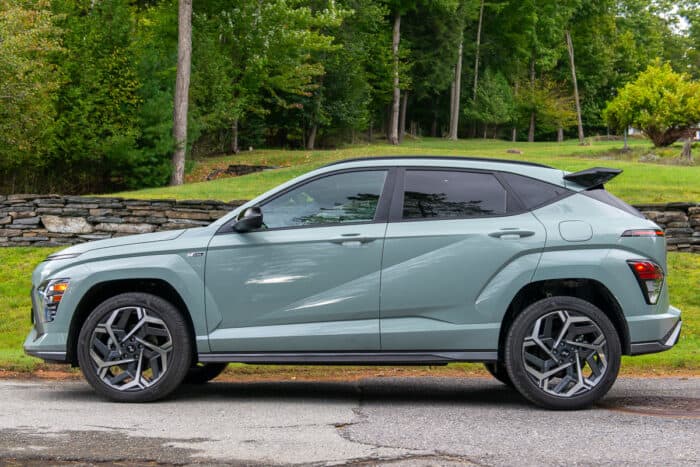
And while the next-generation Kona N-Line isn’t the robust, 276-horsepower Kona N we tested at the Sonoma Raceway back in late 2021 (and chances are, the Kona N won’t be coming back — we asked), it does offer all the go-fast styling, both inside and out, backed by a respectable 190 horsepower, surpassing its competitors.
In terms of looks, the redesigned 2024 Kona takes on an entirely new, more expressive look — from the extra body cladding we’re not keen on (only on the entry-level trims) to that very sleek horizontal full-line LED DRL running east to west above the clean front grill.
Overall, it strikes the right balance of style, performance, and price, catering to most subcompact crossover shoppers. With four broad trims, two gas engine options, and an all-electric version slated for early 2024, the redesigned Kona becomes even more enticing within a busy segment of small crossovers. The new, sleeker look surpasses the outgoing model, particularly up front.
Top Trim Kona: An N-Line with an Upgraded Package
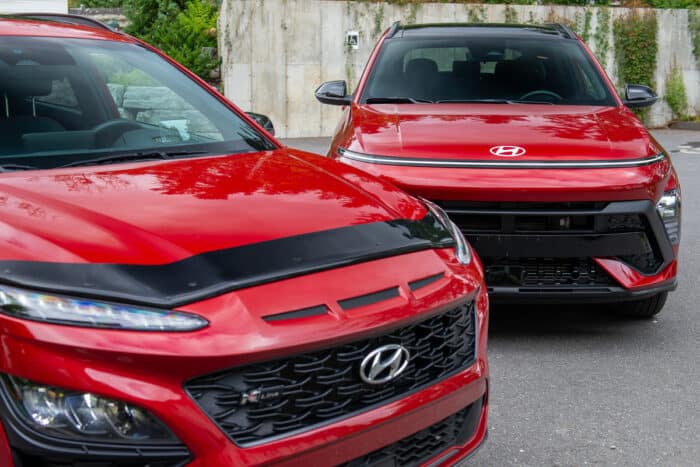
The new Kona trims in the US include SE, SEL, N-Line, and Limited. In Canada, the gradewalk includes Essential, Preferred, N-Line, and N-Line Ultimate. Here, we’re testing the range-topping N-Line Ultimate in Canada or Limited in the US — they’re the same thing, different names in different markets.
The Kona Limited and/or Kona N-Line Ultimate is essentially the second-highest N-Line grade with an upgraded package, adding features like ventilated seats, Remote Smart Parking, a more premium Bose audio system, and more. Fortunately, both get the 1.6L turbo under the hood.
Performance: Two Kona Gas Engine Options for 2024

| 1.6L Turbo Specs | Metric |
|---|---|
| Engine | 1.6L Turbo-GDI DOHC 16-valve Inline 4-cylinder |
| Transmission | 8-speed Automatic Torque Converter |
| Horsepower | 190 hp @ 6000 rpm |
| Torque | 195 lb.-ft. @ 1700-4500 rpm |
| Drivetrain | US: FWD standard, AWD Optional Canada: AWD |
Yes, an all-electric 2024 Kona with a 150kW electric motor is in the works, hitting the market in early 2024. Meantime, we’re stuck with ICE (internal combustion engine) variants — and we’re absolutely fine with that. And so should you be; while not zero-emissions, they’re still fuel-efficient.

The two entry-level, non-N-Line Kona’s get the 2.0L 4-cylinder Atkinson engine, producing 147 horsepower at 6,200 rpm and 132 lb.-ft. of torque at 4,500 rpm, paired with a Smartstream Intelligent Variable Transmission (IVT). The Kona N-Line variants gain the more powerful 1.6L 4-cylinder direct-injected, turbocharged engine making 190 horsepower at 6,000 rpm and 195 lb.-ft. of torque from 1,700-4,500 rpm.
Below, a quick comparison between the two gas engines:
| Spec | 2.0L 16-valve 4-cylinder | 1.6L Turbo 16-valve 4-cylinder |
|---|---|---|
| Horsepower (HP) | 147 @ 6200 | 190 @ 6000 |
| Torque (lb.-ft.) | 132 @ 4500 | 195 @ 1700-4500 |
| Bore & Stroke (mm) | 81.0 X 97.0 | 75.6 X 89 |
| Compression Ratio | 12.5: 1 | 10.0: 1 |
| Fuel System | MPI | GDI |
| Induction System | 2 Step Variable + VCM | Turbocharged |
| Exhaust | Single tip | Dual-tip (N Line) / Single Tip (Limited/N-Line Ultimate) |
The most potent 1.6L turbo in its class
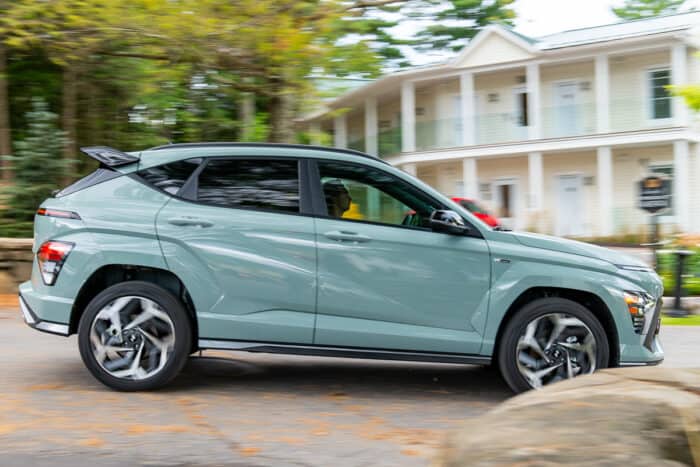
A near 200-horsepower subcompact crossover isn’t typical, especially compared to its rivals with similar engines. The Nissan Kicks and Kia Seltos both offer a 1.6L engine, but the Kicks produces 122 hp and the Seltos 175 hp. We understand it’s not all about horsepower figures, but it’s a good gauge of potential performance and capabilities.
Driving Impressions: Responsive Performance and Confident Acceleration
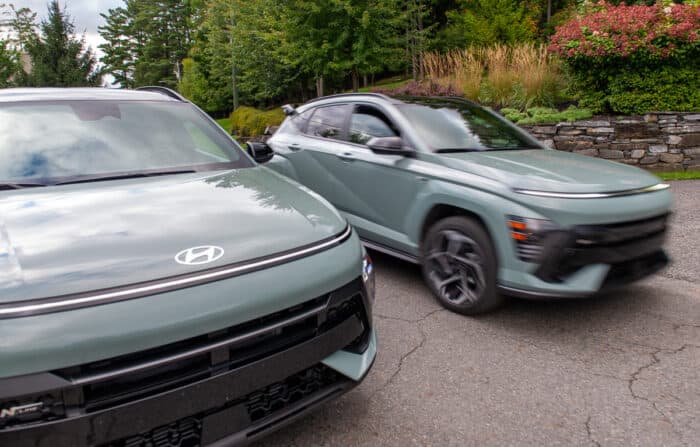
Aside from the gorgeous views, this eastern region of Quebec offers the perfect blend of rolling hills and paved highways to test the new Kona’s performance chops — and during the autumn season, this place lights up with golden hues.
The great thing about subcompact crossovers is their ability to manoeuvre in tight city streets with ease while still offering adequate power and handling on open roads. While not all models check all these boxes, this turbo-powered Kona certainly does.
The 1.6L engine offers smooth, seamless shifting and brisk acceleration when needed, whether climbing up hills or passing cars on the highway. We can thank the Kona N-Line’s low-RPM responsiveness here, where peak torque delivery starts at only 1,700 rpm and holds through 4,500 rpm—overall, offering confident acceleration when needed.
Kona AWD vs. FWD
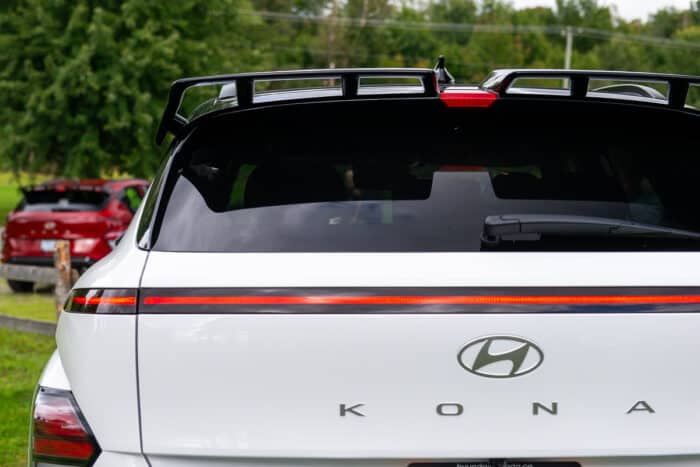
In the US, the N-Line and Limited get the front-wheel drivetrain as standard, with all-wheel drive as an upgrade; in Canada, the top trims get Hyundai’s HTRAC AWD right out the gate (and it’s optional on the lower Essential and Preferred trims).
Worth noting: unlike the FWD Kona models with the MacPherson strut front suspension, coil springs, and a hollow stabilizer bar, the Kona AWD gains a multi-link rear suspension with a stabilizer bar for improved handling. The rear axle is a torsion beam.
2024 Kona N-Line Interior
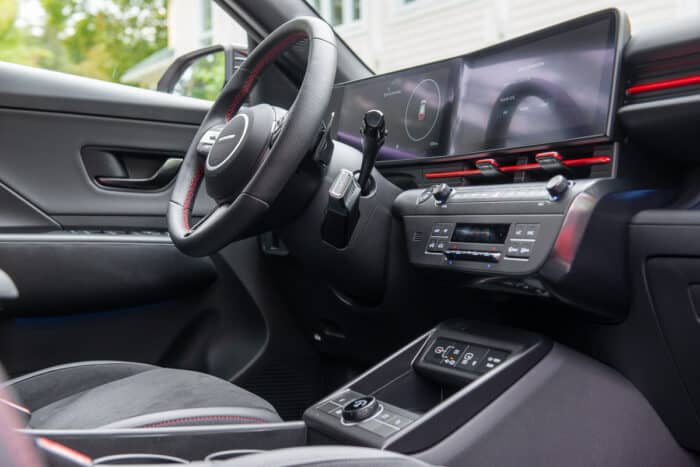
| Spec | Metric |
|---|---|
| Wheelbase | 104.7 in. |
| Length | 171.5 in. |
| Width | 71.9 in. |
| Height (w/roof rails) | 62.2 in. (w/ 17-inch tires) |
| Headroom (w/out sunroof) | 39.9 (front), 38.3 in. (rear) |
| Legroom | 41.7 in., 36.4 in. (rear) |
| Shoulder room | 56.8 in. (front), 55.2 in. (rear) |
Across the board, the entire 2024 Kona gains a completely redesigned interior. A few more notable changes include a 33-percent larger rear cargo area, a large multi-use centre console up front, and a more spacious cabin with 77mm extra legroom space. Plus, all the extra tech you’d expect, including the new 12.3-inch wide integrated digital displays.
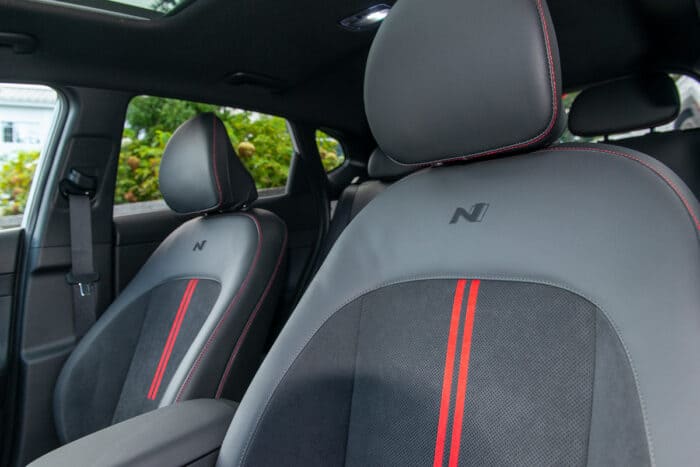
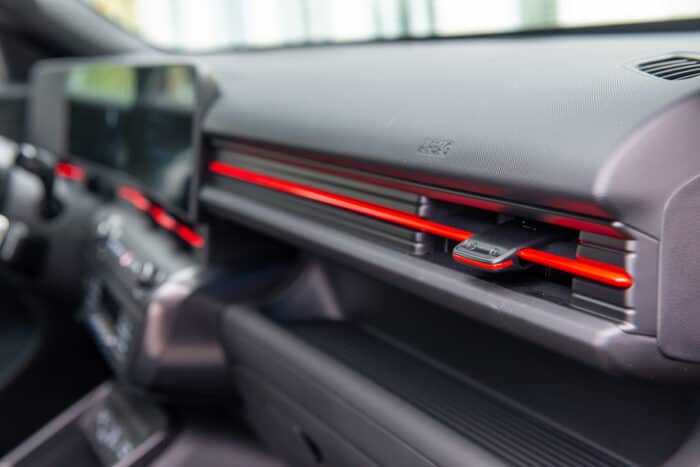
More bells and whistles inside top-level N-Line grades
Inside the regular N-Line grade, Hyundai dials up the sporty vibes with N-Line badging, sportier seats with red accents, metal sport pedals, and N-Line scuff plates. The Limited and N-Line Ultimate go further, adding ventilated seats (not available in the regular N-Line), H-Tex Leatherette-trimmed interior, a surround-view monitor, an auto-dimming rearview mirror with HomeLink (the regular N-Line’s mirror is missing the HomeLink), and the blind-spot view monitor (also unavailable in the N-Line trim).
Redesigned Kona with more dynamic looks

In terms of looks, the redesigned 2024 Kona takes on an entirely new, more expressive look — from the extra body cladding we’re not keen on (only on the entry-level trims) to that very sleek horizontal full-line LED DRL running east to west above the clean front grill.
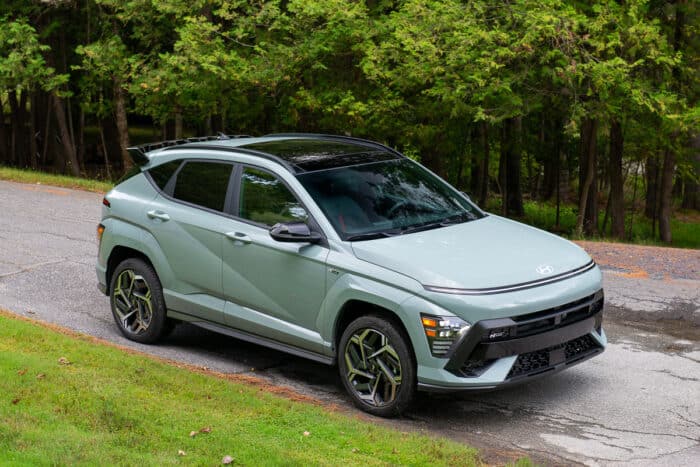
Overall, the new Kona takes on a more rugged guise for 2024, with a broader stance and chrome mouldings running from the belt line to the rear spoiler. The rear, single-strip LED lighting is a nice touch, too, complementing the front DRL.
As with the cabin, the N-Line’s exterior also gains the goods. Including distinct front and rear bumpers, N-Line logos, black side mirrors, 19-inch N-Line alloy wheels, twin-tip exhaust, and N-Line specific rear spoiler. Best part? Body-coloured cladding, so no big black chunks; in all red, the Kona N-Line looks sharp.
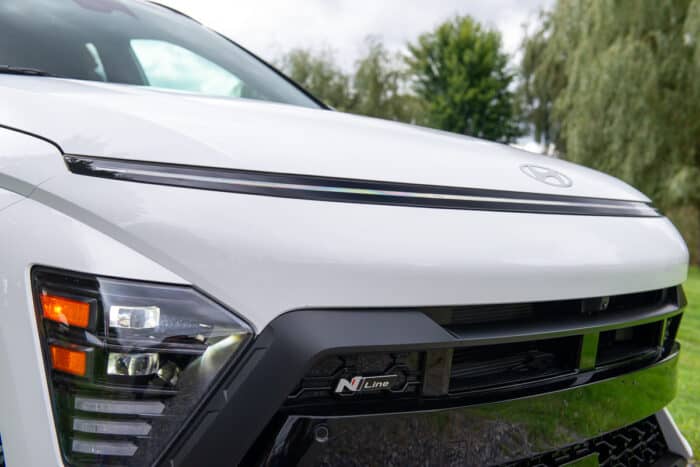
Takeaway
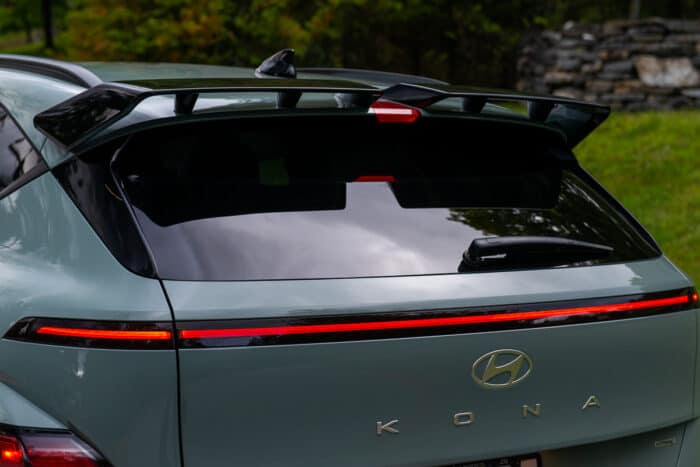
Suppose you like the sports appeal of the N-Line but don’t need the extra bells and whistles, such as the blind-spot view monitor, the auto rearview mirror with the HomeLink feature, ventilated seats, and more. In that case, there’s no harm in skipping these higher Kona Limited/Kona N-Line Utlimate grades and sticking with the regular N-Line. Plus, you’ll save a few bucks as well.
All the top trims — from the N-Line to Limited (US) and N-Line Ultimate (Canada) — offer the same 190-horsepower 1.6L turbo engine, with identical performance and handling. It comes down to the AWD or FWD as the critical performance differentiator.
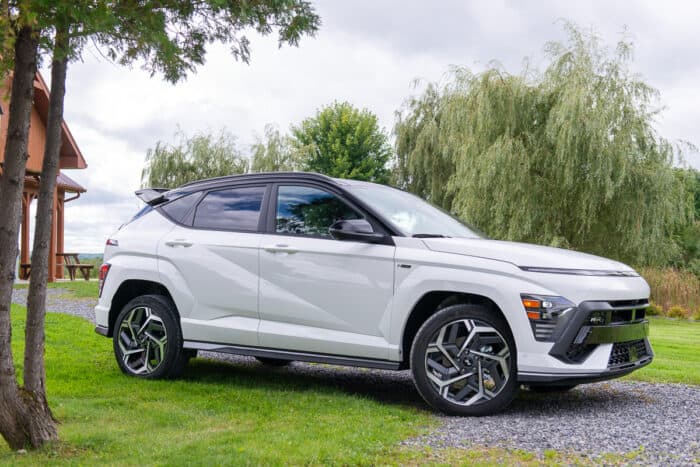
Hyundai expanded this small crossover’s interior and improved storage solutions, which are always a plus. At the same time, it builds on its recent design successes and awards by delivering a futuristic-looking, distinct subcompact in a sea of homogenized competitors. Meantime, we’re still holding out for the underrated Kona N.
2024 Hyundai Kona Limited / N-Line Ultimate Images


